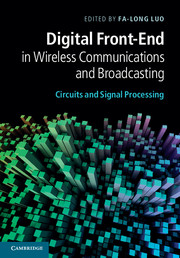Book contents
- Frontmatter
- Contents
- Contributors
- Preface
- Part I Introduction to digital front-end
- Part II DPD and CFR
- Part III DUC, DDC, ADC, DAC, and NCO
- Part IV Digital calibration, imbalance compensation, and error corrections
- 16 Digital compensation and calibration of I/Q gain and phase imbalances
- 17 Joint digital predistortion of I/Q modulator and power amplifier impairments
- 18 Diversity and error compensation in OFDM transceivers
- 19 Front-end architectures and impairment corrections in multimode and multi-antenna systems
- Part V Circuits and system integration in digital front-end
- Index
- References
18 - Diversity and error compensation in OFDM transceivers
principles and implementation
from Part IV - Digital calibration, imbalance compensation, and error corrections
Published online by Cambridge University Press: 07 October 2011
- Frontmatter
- Contents
- Contributors
- Preface
- Part I Introduction to digital front-end
- Part II DPD and CFR
- Part III DUC, DDC, ADC, DAC, and NCO
- Part IV Digital calibration, imbalance compensation, and error corrections
- 16 Digital compensation and calibration of I/Q gain and phase imbalances
- 17 Joint digital predistortion of I/Q modulator and power amplifier impairments
- 18 Diversity and error compensation in OFDM transceivers
- 19 Front-end architectures and impairment corrections in multimode and multi-antenna systems
- Part V Circuits and system integration in digital front-end
- Index
- References
Summary
Introduction
Digital modulation techniques can be largely divided into two categories. One is single-carrier modulation, which utilizes a single radio frequency (RF) to transmit data. The other is multi-carrier modulation, which utilizes simultaneously modulated multiple RF carriers in order to combat inter symbol interference (ISI) while increasing communication bandwidth. This chapter focuses on a particular type of multi-carrier modulation known as Orthogonal Frequency Division Multiplexing (OFDM). The idea of OFDM [1] was proposed in the 1960s followed a few years later by the Discrete Fourier Transform (DFT) based implementation algorithm [2]. Then, OFDM became practical and has been popular in a number of applications such as asymmetric digital subscriber line (ADSL), wireless local area network (WLAN), digital TV broadcasting (DTV). It also has become a strong candidate for 4th generation cellular land mobile radio system.
It is well known that OFDM modulation and demodulation can be implemented by IDFT and DFT. But in actual implementation, not only those DFTs but also several error compensation mechanisms are indispensable because orthogonality between parallel transmitted subcarrier signals are easily destroyed by synchronization errors such as RF error, clock sampling rate error, and FFT window position shift. When applying OFDM technology for mobile communication, Doppler induced RF errors easily distort a reception performance. Therefore the main contents of this chapter are two fundamental techniques to realize high-performance OFDM communication systems. These are Diversity technologies and Synchronization error Detection and Compensation methods. After this, real hardware implementation examples and their data are summarized.
- Type
- Chapter
- Information
- Digital Front-End in Wireless Communications and BroadcastingCircuits and Signal Processing, pp. 531 - 572Publisher: Cambridge University PressPrint publication year: 2011



